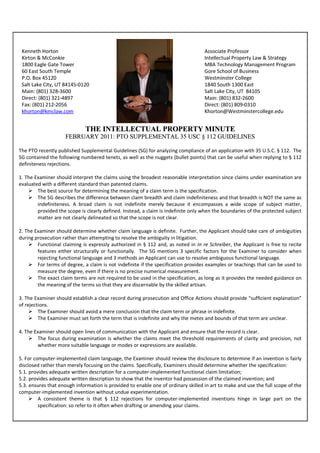
Feb 2011 Newsletter
- 1. THE INTELLECTUAL PROPERTY MINUTE FEBRUARY 2011: PTO SUPPLEMENTAL 35 USC § 112 GUIDELINES The PTO recently published Supplemental Guidelines (SG) for analyzing compliance of an application with 35 U.S.C. § 112. The SG contained the following numbered tenets, as well as the nuggets (bullet points) that can be useful when replying to § 112 definiteness rejections. 1. The Examiner should interpret the claims using the broadest reasonable interpretation since claims under examination are evaluated with a different standard than patented claims. The best source for determining the meaning of a claim term is the specification. The SG describes the difference between claim breadth and claim indefiniteness and that breadth is NOT the same as indefiniteness. A broad claim is not indefinite merely because it encompasses a wide scope of subject matter, provided the scope is clearly defined. Instead, a claim is indefinite only when the boundaries of the protected subject matter are not clearly delineated so that the scope is not clear. 2. The Examiner should determine whether claim language is definite. Further, the Applicant should take care of ambiguities during prosecution rather than attempting to resolve the ambiguity in litigation. Functional claiming is expressly authorized in § 112 and, as noted in In re Schreiber, the Applicant is free to recite features either structurally or functionally. The SG mentions 3 specific factors for the Examiner to consider when rejecting functional language and 3 methods an Applicant can use to resolve ambiguous functional language. For terms of degree, a claim is not indefinite if the specification provides examples or teachings that can be used to measure the degree, even if there is no precise numerical measurement. The exact claim terms are not required to be used in the specification, as long as it provides the needed guidance on the meaning of the terms so that they are discernable by the skilled artisan. 3. The Examiner should establish a clear record during prosecution and Office Actions should provide “sufficient explanation” of rejections. The Examiner should avoid a mere conclusion that the claim term or phrase in indefinite. The Examiner must set forth the term that is indefinite and why the metes and bounds of that term are unclear. 4. The Examiner should open lines of communication with the Applicant and ensure that the record is clear. The focus during examination is whether the claims meet the threshold requirements of clarity and precision, not whether more suitable language or modes or expressions are available. 5. For computer-implemented claim language, the Examiner should review the disclosure to determine if an invention is fairly disclosed rather than merely focusing on the claims. Specifically, Examiners should determine whether the specification: 5.1. provides adequate written description for a computer-implemented functional claim limitation; 5.2. provides adequate written description to show that the inventor had possession of the claimed invention; and 5.3. ensures that enough information is provided to enable one of ordinary skilled in art to make and use the full scope of the computer-implemented invention without undue experimentation. A consistent theme is that § 112 rejections for computer-implemented inventions hinge in large part on the specification: so refer to it often when drafting or amending your claims.